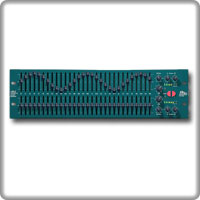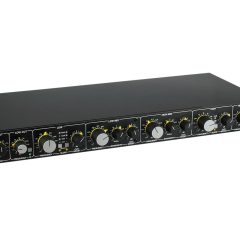| Content |
BSS Opal FCS-966 Constant Q Graphic Eq
Graphic equalisers are found in just about every sound application, from room contouring to feedback control and general audio sweetening.
Traditionally, much general eq'ing takes place on the faders alone, but this restricts the use of the faders at each end of the scale for further precision eq work. So we provided the Opal FCS-966 with separate LF and HF contour filters which can change an overall sound balance without disturbing a detailed room or loudspeaker response.
These filters are very musical gentle boost and cut shelving filters which can be used to add (or remove) room effects that change with temperature, audience numbers or humidity.
All these effects can be easily made without disturbing the critical fader settings already made.
Constant Q Filters
The modern generation of graphic eq's
uses the Constant Q topology, pioneered by BSS Audio, which means that the filter width is constant whatever the fader gain setting.
Compared to the earlier 'gyrator' style of filters, Constant Q filters provide a smoother and more predictable interaction between adjacent faders and the resulting eq curve more closely resembles the actual fader positions.
More Gain Control Per Filter
Each eq fader has +/-15dB of adjustable gain, more than many competitive graphic eq's. The faders are long-throw 45mm types for precision control.
High Pass Filter
Also provided on the FCS-966 is a sweepable high-pass filter which can be used very effectively to restrict the low-energy output for better amplifier and loudspeaker performance. Stage monitors also benefit from the application of a high-pass filter to remove bass signals e.g. from vocal-only wedges.
Metering
BSS Audio believes in providing engineers with information, and the FCS-966's 8-segment led meter shows output level and warns of signal clipping within the eq. When the unit is switched to bypass, the meter will read the input level, allowing accurate matching of the 'dry' and equalised signals using the gain control.
Centre Bypass
When any eq fader is in its centre detent position, the filter is automatically bypassed, for optimum performance.
Input/Outputs
All the inputs and outputs of the FCS-966 are electronically balanced, with optional transformer balancing. To make installation of the FCS-966 easier, we've provided three differerent interface connectors: XLR-type, 1/4" TRS jack and Phoenix/Combicon screw terminals.
Relay Bypass
The EQ IN buttons switch the EQ path
into circuit. When switched out, or power fails, a high-quality relay switches the input signal directly to the output connectors.
Control Descriptions
Faders
30 EQ filter faders on ISO centres, each with nominal +/-15dB of gain. Positive centre-detent on 45mm long-throw precision faders.
HP Filter
Sweepable high pass filter, frequency adjustable from OUT (flat) up to 250Hz.
LF Contour
Smooth shelving filter, +/-6dB of gain at 50Hz
HF Contour
Smooth shelving filter, +/-6dB of gain at 14kHz.
GAIN
Used for overall unity gain adjustment. Adjustable from - infinity to +10dB.
CLIP
Triple-point clip detector that indicates red when the internal signal is clipping at any one of three critical points.
LED Meter
Shows output signal level (input signal when eq is bypassed) from -24dBu to +18dBu in 8 steps. |
INPUT
Connectors: 1/4" TRS, female XLR (pin 2 hot)
Type: Electronically balanced/unbalanced, RF filtered
Impedance: Balanced 40k ohm, unbalanced 20k ohm
Max Input Level: >+21dBu balanced or unbalanced
CMRR: >40dB, typically >55dB at 1kHz
OUTPUTS
Connectors: 1/4" TRS, male XLR (pin 2 hot)
Type: Impedance-balanaced/unbalanced, RF filtered
Impedance: Balanced 100 ohm, unbalanced 50 ohm
Max Output Level: >+21dBu balanced/unbalanced into 2k ohm or greater
>+18dBm balanced/unbalanced (into 600 ohm)
SYSTEM PERFORMANCE
Bandwidth: 20Hz to 20kHz, +0.5/-1dB
Frequency Response: 50kHz, +0.5/-3dB
Dynamic Range: Typically >112dB
Signal-to-Noise: Typically >95dB
THD+Noise: |
The Rane ME 15S microGraphic Equalizer is a two-channel, 2/3-octave design with 20 mm sliders in a single rack space unit. It features a Range switch for high slider resolution in the ±6 dB mode, equivalent resolution to 45 mm sliders found on the DEQ 60L. The ±12 dB mode provides a wide range of control over system audio.
The active filter sections feature Raneʼs innovative constant-Q (constant bandwidth) design. Constant-Q means the bandwidth of each individual filter is guaranteed to be narrow enough to prevent unwarranted interaction between filters, yet wide enough to produce exactly the type of correction curve demanded by even the most unusual acoustic surroundings. This differs dramatically from conventional designs of the past, encumbered with the unfortunate characteristic of changing bandwidth when changing boost/cut amounts.
Front panel controls and indicators include an overall rotary Level control for each channel as well as Overload indicators. Passive pushbutton Bypass switches feature LED indicators, avoiding ambiguity by being on when the unit is Bypassed. (A passive Bypass switch requires no power to operate. This allows completion of the audio path should power fail in the ME 15S.)
Inputs and Outputs are electronically balanced designs, capable of unbalanced operation when required. They accept and drive all possible signal levels into normal load impedances. Balanced applications choose between the XLR or 1/4" Tip-Ring-Sleeve connectors. Unbalanced sources also may tie to the ME 15S through mono 1/4" connectors (no ring connection).
Features - Constant-Q Bandwidth Design
- Overall Level Controls and Passive Bypass Switches
- 20 mm Filter Slide Controls with ±6 dB or ±12 dB Slider Range
- Infrasonic, Ultrasonic, & RFI Filters
- Balanced XLR and 1/4" TRS Inputs and Outputs
- Universal internal switching power supply (100-240 VAC)
|
DBX 2215 Dual 15-Band Graphic Equalizer with Noise Reduction
It's amazing. One little button. So much effect. dbx? Type III? Noise Reduction is an entirely new concept... virtually instantaneous encode/decode within the circuitry of the box. We started out to build the finest EQs possible, boxes with the heritage and performance to rival our famous 30 Series EQs. And to no one's surprise they came out awfully darn good. (Ask to see the Audio Precision plots compared to the competition.) But then, Roger (our chief engineer, a nice guy, as far as engineers go) got the crazy idea of putting this new noise reduction stuff in the box. We listened to it and were amazed. The EQs sounded great without it but with it the performance was nothing short of incredible. Check it out yourself and see.
But hey, Roger wasn't about to stop there. PeakPlus? Limiter. Who knows more about limiting than the folks at dbx; nobody... that's who. So when the guys were developing this new series of EQs they wanted something that would be unique to these EQs. That's when Roger got another one of his bright ideas and said "I bet they'll work a lot better if there's a cool limiter built in." Next thing you know, all the guys are in the studio amazed at the new limiter Roger had designed specially for the 20 Series. Once again, hearing is believing... With a threshold range of 0dbu to plus 20dbu, the patent-pending PeakPlus limiter is designed to tame your program material from the subtlest nuances to the rowdiest hits. Also, the four stage LED ladder gives you a great visual indication as to what the limiter is doing.
20 Series EQs. You used to have to settle for second best in a reasonably priced EQ but not any more. With the new 20 Series from dbx Professional Products you get a great EQ circuit, a graceful yet powerful limiter and the revolutionary new design of the Type III Noise Reduction. Check out the dbx 20 Series graphic EQs at your pro audio outfitter. You'll see, with the 20 Series EQs you get MORE!!!
SPECIFICATIONS:
|
INPUT
| |
Connectors:
|
1/4" TRS, female XLR (pin 2 hot), and barrier terminal strip
| |
Type:
|
Electronically balanced/unbalanced, RF filtered
| |
Impedance:
|
Balanced 40k ohm, unbalanced 20k ohm
| |
Max Input Level:
|
>+21dBu balanced or unbalanced
| |
CMRR:
|
>40dB, typically >55dB at 1kHz
| |
OUTPUTS
| |
Connectors:
|
1/4" TRS, male XLR (pin 2 hot), and barrier terminal strip
| |
Type:
|
Impedance-balanaced/unbalanced, RF filtered
| |
Impedance:
|
Balanced 200 ohm, unbalanced 100 ohm
| |
Max Output Level:
|
>+21dBu balanced/unbalanced into 2k or greater
>+18dBm balanced/unbalanced (into 600)
| |
SYSTEM PERFORMANCE
| |
Bandwidth:
|
20Hz to 20kHz, +/-0.5dB
| |
Frequency Response:
|
50kHz, +0.5/-3dB
| |
Noise Reduction In:
|
(+/-6 and +/-15dB range):
| |
Signal-to-Noise:
|
>102dB, unweighted, ref: +4dBu, 22kHz measurement bandwidth
| |
Dynamic Range:
|
>120dB, unweighted
| |
Noise Reduction Out:
|
(+/-6dB range):
| |
Signal-to-Noise:
|
>94dB, unweighted, ref: +4dBu, 22kHz measurment bandwidth
| |
Dynamic Range:
|
>112dB, unweighted
| |
Noise Reduction Out:
|
(+/-15dB range):
| |
Signal-to-Noise:
|
>90dB, unweighted, ref: +4dBu, 22kHz measurement bandwidth
| |
Dynamic Range:
|
>108dB, unweighted
| |
THD + Noise:
|
| |
* 2 channel 15 2/3 octave band graphic equalizer
* 25Hz - 16kHz frequency control * Constant Q circuitry
(3% frequency accuracy) * Selectable 6dB or 12dB control
* Variable level control * By-pass switch * Overload threshold LED (5dB below clipping) * Ground lift switch * XLR & 1/4" TRS balanced Inputs/Outputs * Power: Selectable 120V/220V voltage
* Dimensions: 1.75" H x 19" W x x 8.5" D / 44.5mm x 483mm x 216mm - 1 space r.m. * Weight: 4.5 lbs. / 2.5kg
XEQ-152 Specifactions:
* Input type: Active balanced / Unbalanced * Output Impedance: |
The class-A circuit used in the EQ-73 is similar to the eq section in the classical 1073 module, without the high pass filter. Additional frequencies have been added and the mid frequency band uses two inductors, the higher value of the second one is used for the two lowest frequencies, 160 Hz and 240 Hz, to achieve a suitable response.
The sound character is warm, punchy, sweet and musical. These classic characteristics have been heard on countless recordings through the years and it is a versatile sound that works very well on most sound sources and in most genres. The essence of this sound is now available at a surprisingly low cost, making it available to nearly everyone.
The EQ-73 has stepped frequency controls that offers a wide selection of frequencies from 20 Hz to 24 kHz.
The Low and High frequency bands are shelving and the mid frequency band is of the bell type.
The control range is +/-15 dB for the two lower bands and +/- 18dB for the high frequency band.
There are separate bypass switches for all three bands.
The EQ-73 is made to be used together with one of our PRE-73 models that has an Insert jack. It can also be used with many other units that has a low level insert jack.
Combining a PRE-73 and an EQ-73, and using a UNITE rack kit to mount them together, one will get a 19-inch 1073-style unit at a low cost and with a great sound!
FEATURES
- Vintage Style electronics. No intergrated circuits in the signal path
- 3-band with a dual inductor based mid frequency band
- Stepped frequency selection
- A wide selection of frequencies from 20 Hz to 24 kHz
- Control range up to +/- 18 dB
- Separate Bypass switches for each band
- Tantalum capacitors in the signal path
- Made to be used together with one of our PRE-73 models with an Insert jack or any other unit with a low level Insert jack
- TRS jack for in-and output connection, the nominal working level is around 18 dBu
- Selectable ground lift switch
- External power supply to avoid interaction with the audio circuits
- Great sound that suits most sound sources and genres
- A solid build quality that will last many years of normal use
|

















Reviews
There are no reviews yet.